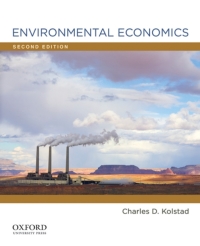Suppose you have a society of (n) identical individuals and the environment. Each individual likes his or
Question:
Suppose you have a society of \(n\) identical individuals and the environment. Each individual likes his or her material possessions as well as access to parks and wilderness areas. In fact, the utility function of each individual is \(U(x ; H)=x+\mathrm{H}-1 / x-1 / H\), where \(x\) is consumption goods and \(H\) is environmental health. \(\mathrm{H}\) attains its highest level when it is pristine: \(H=100\). Consumption of goods degrades the environment but the environment has some ability to heal itself. In fact, the environment has health \(H_{t}=H_{t-1}+g\left(100-H_{t-1}\right)-n x\), where \(H_{t}\) is today's \(H\) and \(H_{t-1}\) is yesterday's \(H\). The environment's ability to cleanse itself, \(g\), is fixed.
a. Simply focusing on the utility function (ignoring the evolution of \(\mathrm{H}\) ), discuss the extent to which the utility function is consistent with (a) biocentrism or (b) anthropocentrism.
b. Suppose we start at \(H=100\). Assume \(\mathrm{g}=0.1\) and \(n=1\). Plot how \(\mathrm{H}\) would evolve for \(x=0.01,0.1\) and 1 .
c. Repeat part (a) except this time plot \(U\) instead of \(H\). Feel free to try other values of \(x\). Can you reach any conclusions about the level of consumption that maximizes utility?
Step by Step Answer:





